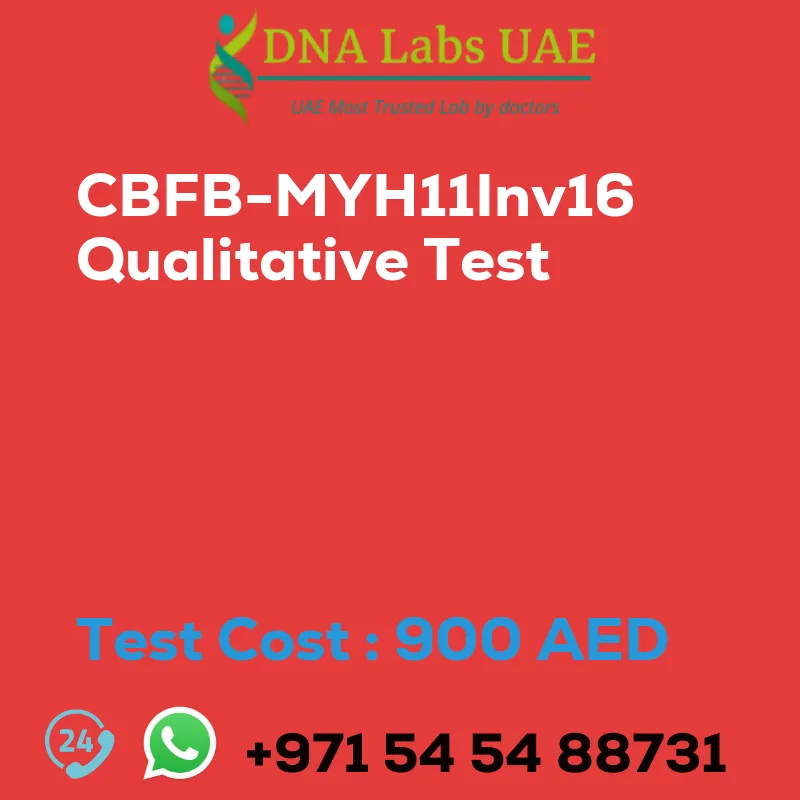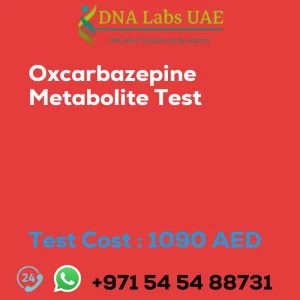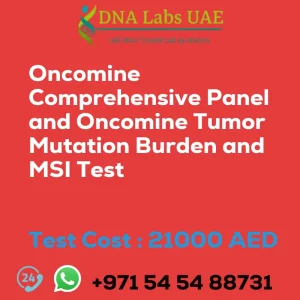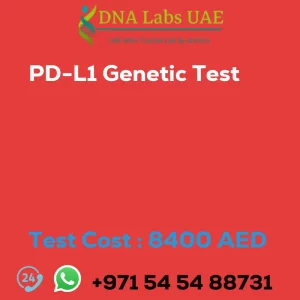CBFB-MYH11Inv16 Qualitative Test
Test Name: CBFB-MYH11Inv16 Qualitative Test
Components: EDTA Vacutainer (2ml)
Price: 900.0 AED
Sample Condition: Bone marrow / Peripheral blood (Transport immediately)
Report Delivery: 3-4 days
Method: Real Time PCR
Test Type: Genetics
Doctor: General Physician
Test Department: DNA Labs UAE
Pre Test Information: CBFB-MYH11 Inv(16) Qualitative test can be done with a doctor’s prescription. Prescription is not applicable for surgery and pregnancy cases or people planning to travel abroad.
Test Details:
CBFB-MYH11[Inv(16)] is a qualitative genetic abnormality that is associated with certain types of leukemia, specifically acute myeloid leukemia (AML). It is a fusion gene resulting from an inversion of chromosome 16, which leads to the fusion of two genes: CBFB (core-binding factor subunit beta) and MYH11 (myosin heavy chain 11). This fusion gene disrupts normal cellular processes and promotes the development of leukemia. It is commonly found in a subtype of AML known as acute myelomonocytic leukemia (AML-M4) and is seen in both adults and children.
The presence of CBFB-MYH11[Inv(16)] is detected through genetic testing, such as fluorescence in situ hybridization (FISH) or polymerase chain reaction (PCR). These tests help identify the abnormality and confirm the diagnosis of AML with inv(16). Qualitatively, the presence of CBFB-MYH11[Inv(16)] has prognostic significance. It is considered a favorable genetic abnormality in AML, as patients with this fusion gene tend to have a better response to treatment and a more favorable overall prognosis compared to other subtypes of AML.
However, it is important to note that individual prognosis can vary, and other factors such as age, overall health, and response to treatment also play a significant role in determining the outcome for patients with CBFB-MYH11[Inv(16)].
Overall, CBFB-MYH11[Inv(16)] is a qualitative genetic abnormality that is associated with a specific subtype of AML. Its presence has prognostic significance and helps guide treatment decisions and predict the overall outcome for patients with this type of leukemia.
| Test Name | CBFB-MYH11Inv16 Qualitative Test |
|---|---|
| Components | EDTA Vacutainer (2ml) |
| Price | 900.0 AED |
| Sample Condition | Bone marrow \/ Peripheral blood (Transport immediately) |
| Report Delivery | 3-4 days |
| Method | Real Time PCR |
| Test type | Genetics |
| Doctor | General Physician |
| Test Department: | |
| Pre Test Information | CBFB-MYH11 Inv(16)] Qualitative can be done with a Doctors prescription. Prescription is not applicable for surgery and pregnancy cases or people planing to travel abroad. |
| Test Details |
CBFB-MYH11[Inv(16)] is a qualitative genetic abnormality that is associated with certain types of leukemia, specifically acute myeloid leukemia (AML). It is a fusion gene resulting from an inversion of chromosome 16, which leads to the fusion of two genes: CBFB (core-binding factor subunit beta) and MYH11 (myosin heavy chain 11). This fusion gene disrupts normal cellular processes and promotes the development of leukemia. It is commonly found in a subtype of AML known as acute myelomonocytic leukemia (AML-M4) and is seen in both adults and children. The presence of CBFB-MYH11[Inv(16)] is detected through genetic testing, such as fluorescence in situ hybridization (FISH) or polymerase chain reaction (PCR). These tests help identify the abnormality and confirm the diagnosis of AML with inv(16). Qualitatively, the presence of CBFB-MYH11[Inv(16)] has prognostic significance. It is considered a favorable genetic abnormality in AML, as patients with this fusion gene tend to have a better response to treatment and a more favorable overall prognosis compared to other subtypes of AML. However, it is important to note that individual prognosis can vary, and other factors such as age, overall health, and response to treatment also play a significant role in determining the outcome for patients with CBFB-MYH11[Inv(16)]. Overall, CBFB-MYH11[Inv(16)] is a qualitative genetic abnormality that is associated with a specific subtype of AML. Its presence has prognostic significance and helps guide treatment decisions and predict the overall outcome for patients with this type of leukemia. |








